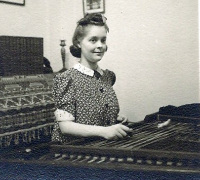Early years.

Toni at age 21.
Toni Koves-Steiner (nee Endrodi) was born on either August 27th or August 28th, 1918, depending on whether you trust her birth certificate or her Mother's account, in Dunbar, West Virginia. Her childhood see-sawed from famine to feast and back again, and she shared adventures and depression-era drama with her three adored brothers and her beloved parents, who lived with her until they died.
Toni’s maternal grandfather, Jeno Felfoldy, could play the cimbalom, which was a common fixture in a Hungarian home, much like a piano would be. Family folklore tells that before immigrating to America, he would put on a fake eye patch and sneak out at night to play with the gypsies. The Felfoldy family, reputedly landed gentry that could trace its ancestry back to the days of King Stephen, was none too happy about this. There is also a version that casts Toni’s Grandmother Ilona (nee Body) as the family cimbalom player. (There are other equally fantastic stories that might be told, but in a Hungarian family, this is to be expected.) Toni's paternal grandfather, Endrodi Sandor (1850-1920) was a reknown Hungarian Poet.
Toni said she fell in love with the cimbalom as a teenager, but living in the U.S. finding a teacher was not easy. Today cimbalom is an established course of study and there are many professionals who play it either as a percussion double or as their main instrument. In Toni's day, professionally, it was part of a gypsy orchestra, period. When the family moved to New York she located legendary gypsy player Zsiga Bela (Hungarian custom puts last names first, so we would call him Bela Zsiga) and he became her teacher.
The cimbalom was being played in New York City's Yorkville’s boites, which at that time were thriving. This is a guess, but I would say it's likely Zsiga Bela played in these spots, and Toni most likely went to hear him as often as possible. It was here she met pianist Louis Koves-Steiner and married. It’s not clear when she began to play professionally. Possibly it was a natural progression from “sitting in” to being offered a job with a band.
Toni’s maternal grandfather, Jeno Felfoldy, could play the cimbalom, which was a common fixture in a Hungarian home, much like a piano would be. Family folklore tells that before immigrating to America, he would put on a fake eye patch and sneak out at night to play with the gypsies. The Felfoldy family, reputedly landed gentry that could trace its ancestry back to the days of King Stephen, was none too happy about this. There is also a version that casts Toni’s Grandmother Ilona (nee Body) as the family cimbalom player. (There are other equally fantastic stories that might be told, but in a Hungarian family, this is to be expected.) Toni's paternal grandfather, Endrodi Sandor (1850-1920) was a reknown Hungarian Poet.
Toni said she fell in love with the cimbalom as a teenager, but living in the U.S. finding a teacher was not easy. Today cimbalom is an established course of study and there are many professionals who play it either as a percussion double or as their main instrument. In Toni's day, professionally, it was part of a gypsy orchestra, period. When the family moved to New York she located legendary gypsy player Zsiga Bela (Hungarian custom puts last names first, so we would call him Bela Zsiga) and he became her teacher.
The cimbalom was being played in New York City's Yorkville’s boites, which at that time were thriving. This is a guess, but I would say it's likely Zsiga Bela played in these spots, and Toni most likely went to hear him as often as possible. It was here she met pianist Louis Koves-Steiner and married. It’s not clear when she began to play professionally. Possibly it was a natural progression from “sitting in” to being offered a job with a band.
